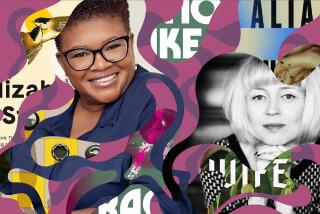What Has Happened to The New Yorker
- Share via
Something has changed when Buzz and The New Yorker finish in a dead heat for the some story. Like Time and Newsweek ending up on the newsstands with the same cover subject in the same week, the April issue of Los Angeles’ struggling, inside-dopey city magazine features an edited monologue by superannuated super-agent Irving Lazar, while The New Yorker features, in its March 29 issue, Lazar as remembered by studio-brat-grown-old Michael Korda. The ever-puckish Korda regales us with Swifty stories in a piece that should have come with a laugh track. Buzz does better with two pages of Swiftian prose and historic photographs of the agent in action.
But if Buzz emerges the winner, how do we emerge, we of book-reading Los Angeles, who used to subscribe to The New Yorker as to a genuinely national magazine? We emerge with another piece of evidence. The New Yorker, under its new editor, has ceased to be a calm magazine, reflecting and shaping a broadly American and democratic culture, and has become an increasingly anxious magazine, buying and selling the buzz. There are people who want the buzz, of course; but having renewed my own lapsed subscription out of hopeful curiosity, I find myself reading each successive issue in fewer and fewer minutes. Rightly or wrongly, I think I already know all I need to know about Irving Lazar.
That The New Yorker of old was an American magazine matters because of what, over the years, has followed from this premise. Minnesotan Garrison Keillor was welcome in The (old) New Yorker because his brand of humor, though decidedly un-New York (as well as un-Hollywood), was unmistakably American. And now? Well, to be sure, Irving Lazar’s Hollywood is farther from New York, as the crow flies, than Garrison Keillor’s Lake Wobegon; but taking both places as mythical, one is on the international celebrity map, the other isn’t, and that makes all the difference. Much of Southern California is without celebrity appeal. John McPhee wrote in The (old) New Yorker about debris flows in the San Gabriel mountains; William Murray wrote about San Diego and Tijuana as twin cities. The unglamorous Southern California they wrote about was fully a part of America; but in The (new) New Yorker, that might not be enough.
With admirable directness, editor Tina Brown told Eric Utne of the Utne Reader (see Columbia Journalism Review, March/April 1993): “I edit for what interests me basically, and I think it is the only way to edit. . . . I feel that if it interests me it interests the readership.” Tina Brown has come to The New Yorker from Vanity Fair, where she was spectacularly successful putting together a package joining glamour to gossip at just the point where the line between them begins to vanish.
Michael Korda on Swifty Lazar would have interested the Brown of Vanity Fair no less than the Brown of The New Yorker. But what of the readership of the two magazines? How deeply does the average New Yorker reader crave glamour? If the readership Brown has inherited at The New Yorker, as distinct from one she may be trying to attract, responds less to glamour than she does, her assumption--”if it interests me it interests the readership”--becomes dubious.
Location counts in the pages of The (new) New Yorker in a second, less mythical way. In Saul Steinberg’s endlessly pirated New Yorker cover, a foreshortened United States is viewed from an implicitly smug Manhattan. If Steinberg were alive to do a cover for The (new) New Yorker, his view would have to rotate 180 degrees: It would have to look eastward across the Atlantic rather than westward toward the Pacific. Thus, in the April 5 issue, English drama critic John Lahr reviews revivals of Oscar Wilde’s “An Ideal Husband” and “The Importance of Being Earnest” in London’s West End. In the same issue, book critic Richard Jenkyns reviews Charles Sprawson’s “Haunts of the Black Masseur,” noting: “The book is about swimming--in ancient Rome, in Japan, Germany and America, but, above all, in England, to which four of the eight chapters are devoted. . . .”
Tina Brown is an English woman living in America; and since her arrival at The New Yorker, not only have specifically English topics and English contributors appeared with greater frequency in the magazine but, on too many occasions to ignore, so has the special perspective of someone operating between London and New York. It is almost as if The (new) New Yorker were attempting to manage from this side of the water the transatlantic marketing trick that the Economist has managed from the other side: to be a magazine for sophisticates at home in both cultures, the inhabitants of a glittering Anglo-American archipelago.
In one recent New Yorker story (“Full Moon Over Milan,” April 5) Andrea Lee writes:
“Her friend Clay with typical extravagance says that the phrases are distress signals from the American in her who refuses to die, but Merope has never intended to stop being American. Her grandparents came from a British Caribbean island called Montserrat. . . .” Later in the story, we hear of “a family vaguely highborn, vaguely European, vaguely American . . . and of a childhood passed in a sort of whistle-stop tour of the oddest combination of places--Madrid, Bristol, England; Gainesville, Florida.”
This is perfectly legitimate material for fiction, but a predilection for such material is not likely to link Brown to too many of her magazine’s readers. This fiction is about her more that it is about them. To be sure, fiction does not play a particularly large role in The (new) New Yorker, and by no means all of what does appear is, in this way, double situated. But some of it is--definitely enough to notice. Katharine Weber’s “Friend of the Family” (Jan. 25) is a story in the form of a long letter from a girl at boarding school in Switzerland. At one point, we read:
“ ‘We can buy you a suit at the chemist’s on the corner--I’ve seen them there,’ Anne said. Victor looked helplessly at me. I didn’t know what he wanted me to say. I remember when Anne patronized mere drugstores.”
In the April 19 issue, two stories appear. In Donna Tartt’s “Tam -O’-Shanter,” the protagonist is an aging English actor living in Burbank: “He’d been in the States for fifty years, had almost completely lost his accent. . . .” In Fay Weldon’s “Wasted Lives,” the narrator, apparently English, works for a U.S. film company, from their London office. We meet him on a dalliance in Eastern Europe.
Stories by newer writers like Lee and Weber are a good clue to the new mental location of the magazine. With an Alice Munro or a William Trevor, the editor buys the author’s name; with a Weber or a Lee, she buys the story’s content and may yield more freely to her own tastes. Weldon, shrewd and merry, writes the story she wants to write and packages it for sale to Brown by making the protagonist, who could have been any Englishman, an English filmmaker working for an American firm.
In nonfiction, Britain is only somewhat less on the new editor’s mind. In “Letter from London: Real Britannia” (April 12), English novelist Julian Barnes recounts a controversy raging in Britain over a new postage stamp. It is in the “back of the book,” however, where the criticism clusters, that Britain looms largest of all. Working backward from the April 5 issue, and looking just at book reviews, we find on March 29 “A Life at the Center” (Random House), the autobiography of Labour Party leader Roy Jenkins; on March 22, “Poet and Dancer” (Doubleday), a novel by Ruth Prawer Jhabvala, a Polish Jew who moved to England at the age of 12, later married an Anglo-Indian, and has achieved fame as a screenwriter for British producers; on March 15, “Operation Shylock” (Simon & Schuster), Philip Roth’s new novel; on March 8, Thomas Powers’ “Heisenberg’s War” (Alfred A. Knopf); and on March 1, Anne Chisholm and Michael Davie’s “Lord Beaverbrook: A Life” (Alfred A. Knopf), a biography of the British newspaper magnate. One may well question whether, to begin with, New Yorker readers welcome this heavy new emphasis on biography and autobiography. But, that aside, it is even more questionable whether the magazine’s American readers, with five major slots to fill, would fill three of them with Roy Jenkins, Ruth Prawer Jhabvala and Lord Beaverbrook.
There is, finally, the vexed matter of The New Yorker’s seriousness. An occasional burden in The (old) New Yorker, seriousness has become a hump on the back of The (new) New Yorker. “The Talk of the Town” is the case most in point. If that feature had its somber moments under Brown’s predecessors, her division of it into two features--the new one being the opening, unsigned essay offered as “Comment”--has turned the somber into the suffocating. Hendrik Hertzberg, who edits and often (more often than he would like, one hears) writes this feature, was admired at New Republic for his uniquely sly, wry style. Sadly, in the lighter company he is now keeping at The New Yorker, he himself has come to seem heavy.
In The (old) New Yorker, Jonathan Schell’s much-debated “Talk” pieces on war and peace, whether you liked them or not, retained the private, almost confidential tone of the long-running symposium in which they appeared. At its frequent best, “The Talk of the Town” read like the edited transcript of into-the-night talk at Columbia University or NYU. The voices seemed to be those of precocious, urbane undergraduates whose usual game was a friendly competition in uncovering the delights of the city. Schell’s contributions changed the subject of that conversation without altogether breaking its mood.
In the new feature, “Comment,” Hertzberg is structurally required to break the mood completely. It is as if the dean, sorry to hear that so much youthful eloquence was being wasted in the dorm, had said, “Young man, from now on, I want a weekly essay out of you, and I give you fair warning: I intend to read it aloud to the board of trustees as we convene.”
What remains of “The Talk of the Town”--now edited by Alexander Chancellor (like Brown, a Briton)--has itself become a fairly joyless round of duty calls to the buzz.
The state of seriousness of The New Yorker is inseparable from the state of its humor. As Oscar Wilde once wrote, if nothing is serious, nothing is funny. Am I alone in thinking that The New Yorker has lost its sense of irony? The cartoons rarely catch one quite by surprise. The hilarious misprints have mostly vanished. The humorous set pieces, too often enough done in the upper-class British manner of high silliness, seem as “Comment” does, ordered up and un-spontaneous.
Nothing in literature is harder to talk about than humor; but in this instance, one may note at least that if Vanity Fair lacked humor under Tina Brown’s management, the reason may be that humor and glamour stand in deeper ultimate enmity than humor and gravity do. Glamour--look at the fashion ads--has a straight face or, at best, a carefully composed smile. We should not be surprised, then, if as The (new) New Yorker has grown more glamorous, it has also grown less funny.
According to Eric Utne, The New Yorker’s newsstand sales are sharply up, but advertising is not. For a while, The New Yorker will be, in magazine parlance, a “hot book,” but it may not stay hot. In a crowded field, its losses may cancel out its gains. All bets are hedged.
For those who have seen The New Yorker as an important vehicle in the formation of a national literary culture, the hope must be that Tina Brown will belatedly discover the rest of America. For those who have welcomed the crafty humor of The New Yorker as a haven from the din of celebrity, the hope, however faint, must be that this most glamorous of editors will lose at least some of her composure and loosen, at least somewhat, her fabulous grip. To some extent, The (old) New Yorker was a made magazine, made from scratch, like Vanity Fair. To a much greater extent, however, it was a magazine that happened. It will become funny again if and when it starts happening again.
More to Read
Sign up for our Book Club newsletter
Get the latest news, events and more from the Los Angeles Times Book Club, and help us get L.A. reading and talking.
You may occasionally receive promotional content from the Los Angeles Times.







